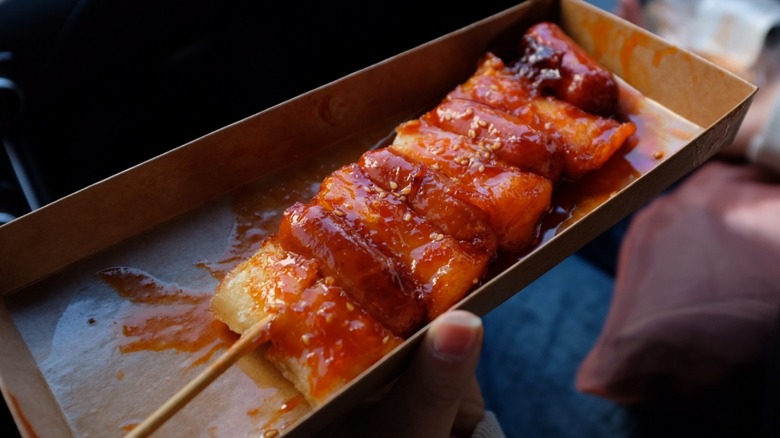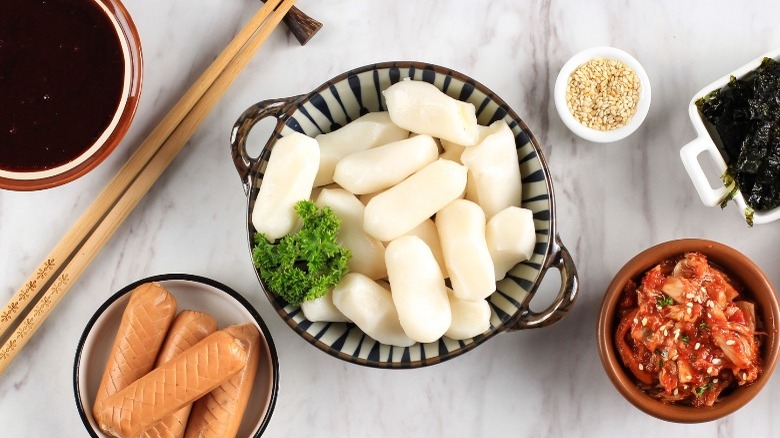Sotteok Sotteok: A Korean Street Food Favorite
We may receive a commission on purchases made from links.
There's no denying the popularity of Korean food globally, especially here in America. In fact, according to food and beverage analytics company, Spoonshot, Korean cuisine saw a sharp 90% increase in interest in 2021 (via The Food Institute). It's so popular that American chain restaurants like Shake Shack tried to get in on the action last year with their controversial take on Korean fried chicken, per Today. Among the most popular K-cuisine food trends like mouth-watering Korean fried chicken, saucy tteokbokki (spicy rice cakes), crispy french fry-dotted Korean corn dogs, savory bibimbap and bulgogi, spicy kimchi fried rice, and others lies another tasty Korean dish called sotteok sotteok.
A more portable riff on tteokbokki (so popular stateside that it's now being sold in the freezer section at Trader Joe's) sotteok sotteok is a sweet and spicy sauced dish that features small sausages and garae-tteok (chewy cylindrical rice cakes) alternating on a skewer to an absolutely crave-worthy effect. But what is the magic of sotteok sotteok?
History of sotteok sotteok
Attributed to Korean comedian and television host, Lee Young-ja during one of her many television cooking show appearances on KBS World TV, was named simply for what it is — sausage or "sosiji" (shortened to "so") and rice cake ("tteok") alternating on a skewer (via YouTube). This doubled-up word pattern of "so" and "tteok" is both a portmanteau and a mirror of the dish, becoming "sotteok sotteok." While this skewered sausage version of tteokbokki often comes glazed with a signature sticky-spicy gochujang-ketchup sauce, it can also be topped with mustard and ketchup and can even include melted cheese (per London is Hungry and Maangchi).
A South Korean favorite, it's now sold at gas station rest stops and in pojangmacha tents (vinyl tent-covered street food stalls). One look at Lonely Planet's guide to the best street food in South Korea and you'll soon realize that it was only a matter of time before sotteok sotteok's delectable combination made its debut (with or without Lee Young-ja's help) given the list of South Korea's most-favored street food items including tteokbokki, soondae (Korean sausage), and kkochi (skewers). Lonely Planet notes, "Lots of street eaters take a combo approach, ordering tteokbokki and soondae together and dipping their sausage in the spicy tteokbokki sauce."
What's in sotteok sotteok?
If you're familiar with the spicy stir-fried comfort that a bowl of tteokbokki brings, then you already have an idea of the knockout flavor and tempting toothsomeness awaiting you in sotteok sotteok. Both dishes are made with chewy Korean rice cakes or tteok, which come in glutinous or non-glutinous varieties and an assortment of shapes (via Asia Society). They are doused in a sticky gochujang-based sauce and include mini Vienna sausages that impart a slightly smokey flavor to the dish. These tiny sausages are then alternated with the same cylinder-shaped non-glutinous tteok used in tteokbokki, called garae-tteok, and are most often brushed with the salty-sweet and mild earthy heat of deeply flavored ketchup and fermented chili sauce combination. Devotees of sotteok sotteok encourage experimenting with your favorite sauce, some popular sauces used in Korea include honey mustard and even spicy American barbecue sauce, according to Curious Kimchi.
If you're lucky enough to have a neighborhood Korean restaurant or food cart serving sotteok sotteok near you, you might end up eating out a lot more than you planned after tasting it. But even if you don't have a purveyor nearby or you find yourself living in a food desert with nary an Asian market in sight, you can make this saucy treat anytime you want with just a few ingredients and some careful planning.
How to make at-home sotteok sotteok
If you're making sotteok sotteok in the comfort of your own kitchen, your biggest obstacle may be getting two of its three main ingredients: garaetteok and gochujang. Both can easily be found in Asian markets, but no problem if you don't have access to where you live. Amazon carries both and even has a couple of gluten-free versions of the sauce available. If you're feeling adventurous, you can make your fresh garaetteok in about 25 minutes, according to cookbook author and Saveur-ranked food blogger Sue Pressey at My Korean Kitchen. All it takes is wet-milled rice flour, corn starch, salt, water, and sesame oil.
If you're not making the tteok yourself, you'll need to rehydrate it. Frozen garaetteok can be hard and dry if not soaked. My Korean Kitchen recommends soaking them in warm water for about 10 minutes before boiling them. Once you have rehydrated your tteok and scored your mini-sausages, begin assembling on bamboo skewers. Start by piercing each tteok and sausage through the middle, sliding them onto skewers in an alternating pattern. Then baste with its signature sauce (a combination of Korean gochujang, soy sauce, ketchup, and honey or brown sugar) before pan-frying until the sausages and rice cakes are crispy on the outside and chewy-tender inside. Popular Korean influencers Aaron and Claire recommend using your air fryer for a quick and delicious hack (via YouTube).



